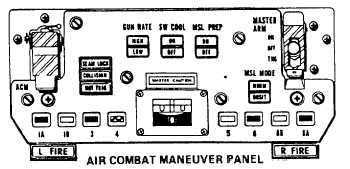CHAPTER 7
WEAPONS SYSTEMS
As a result of major developments in current
aircraft design and computer technology, modern
aircraft are able to deliver sophisticated weapons to a
target automatically and with unprecedented
accuracy. These aircraft are designed and built as a
completely integrated weapons system. The weapons
subsystems are interconnected and dependent, to
some extent, on each other or on other aircraft
systems. For example, the bomb release system in
some modes of operation is dependent upon the
aircraft’s flight control system. In another example,
the missile system is interconnected with the aircraft’s
radar system for missile guidance. In addition to
delivering weapons more accurately, the
computer-controlled weapons systems provide a
higher degree of safety by significantly reducing the
degree of human error.
When avionics technicians are testing, trouble-
shooting, or performing maintenance on an avionics
system, they must be aware of the effects the system
can have on ordnance, either loaded or to be loaded on
the aircraft. To complicate matters, most aircraft in
the Navy’s inventory are multimission aircraft. The
F/A-18 is used as a fighter and an attack aircraft. The
P-3C is an antisubmarine warfare (ASW) and a patrol
aircraft. The aircraft discussed in this chapter are the
fighter, fighter/attack, and the ASW aircraft.
FIGHTER AIRCRAFT WEAPONS
SYSTEMS
Learning Objective: Recognize various
fighter aircraft weapons systems and their
operating functions.
The following discussion of the F-14 and the
F/A- 18 aircraft will provide you with information on
the available aircraft armament systems and the basic
controls and components for both the fighter and the
fighter/attack aircraft.
F-14 AIRCRAFT WEAPONS SYSTEMS
The F-14 aircraft is a two seat, supersonic fighter
aircraft. The aircraft’s armament system consists of
the following systems and subsystems: armament
basic controls and components, missile control
system, multiple weapons release system, M61A1
20-mm automatic gunfire control system,
AN/AWW-4 fuze function control system,
AN/ALE-29A or AN/ALE-39 decoy dispensing
system, and a jettison system.
Armament Basic Controls and Components
The F-14 armament system consists of the
following basic controls and components that are
common to all systems:
the air combat maneuver
(ACM) panel, the armament control panel, the display
control panel, the control stick, the master light
control panel, the landing gear handle, and the
armament safety override switch.
A I R C O M B A T M A N E U V E R ( A C M)
PANEL.— The ACM panel (fig. 7-1) is located on the
forward cockpit center console. It contains switches
for missile preparation, missile operating mode
selection, and for arming the systems. Indicators are
provided to inform the pilot of weapon status, when
the missile is locked on to the target, and when the
missile is ready to be launched. The ACM panel
switches are discussed in the following paragraphs.
Master Arm Switch.— This switch is important
to the avionics technician who must be aware that
when the guard switch is raised and the switch is set to
ON, a master arm signal is sent to the armament panel
to enable the master arm logic circuitry.
Figure 7-1.-Air combat maneuver (ACM) panel.
7-1

